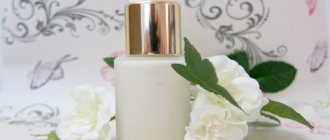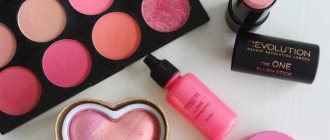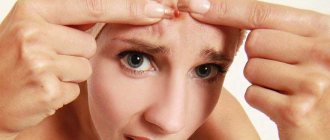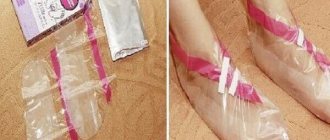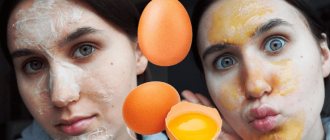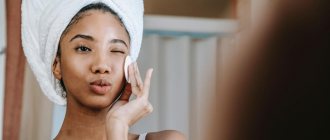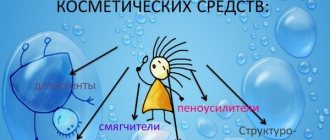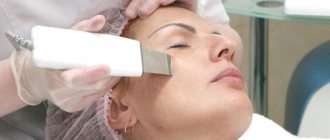What is a facial serum?
Facial serum or serum came to cosmetology from pharmaceuticals. They are a highly effective remedy and will also help in combination when other means fail.
A serum is a concentrated product that aims to moisturize the skin from the inside, so serums easily penetrate into the deepest layers of the skin.
Serums are an intermediate and additional step in comprehensive skin care. It is recommended to “cover” serums with face cream, with the exception of some specimens. The packaging should always indicate how to use the facial serum!
Serum application techniques.
- Tapping - we move our hands away from the face and with a good shock wave we tap the entire face and neck along the lateral lines for about a minute
- Pinching - along the same lines, first from bottom to top, then in the opposite direction for about - a minute
- Rolling - use the bases of your palms to squeeze out the swelling from the center of the face to the periphery
- We place our elbows on some surface and, starting from the chin, continue to remove excess fluid from the facial tissues, reaching the cheekbones and then in the opposite direction. The bases of the palms slide under the weight of the head, there is no need to force the movements, we wait until the skin itself lets through the hands.
If you have a slender face without swelling, then points 3 and 4 do not need to be done.
Why use facial serum?
The effectiveness of facial serums:
- First of all, it is associated with a high concentration of active components , so the products are usually produced in small volumes and a very small amount of product is required when applied. For one application, 1-2 drops of the product are enough.
- The second distinctive feature is the function of preparing the skin for the next stages of care , namely the application of cream. The serum moisturizes the skin, thereby preparing it for the application of the next product. A good example: we noticed that if you drop water on a dry sponge, it will not be absorbed, but on a wet sponge it will immediately disappear. This is how the serum prepares the upper layer of the dermis for the next stages. Its molecules are much smaller and penetrate the skin faster, taking with them the product applied after it, enhancing the effect of creams and making them more effective.
Life hack: apply facial serum before using a sheet mask. The serum will perfectly complement the care and help the components penetrate deeper into the tissue. Serum will make your skin care much more effective
Serums in cosmetics
Women are always looking for new anti-aging cosmetics. Even if the bathroom cabinet is overflowing with jars and bottles, there is always something we haven't tried yet. For example... facial serums.
From advertising, we clearly learned that we cannot do without serums in the difficult task of maintaining “eternal youth.” Today the market offers thousands of products called serums, varying in composition, type and price. Will a drug in the form of a gel be more effective or is it better if it is similar to a light cream? What's special about them and why are they so expensive?
Let's look at the main promises of manufacturers.
Serums are the best solution for skin problems
Data:
Serums are more often developed to solve a specific type of problem, such as pigmentation, fine wrinkles, ptosis, dry skin, etc. But today, with the advent of new cosmetic trends, “general action” serums are also appearing - in advertising they usually say that they will make your skin “ shine". These are actually products that reduce the damage caused by photoaging. Here the struggle takes place in several directions at once: lightening, moisturizing, normalizing microcirculation and increasing elasticity.
Clue:
The most effective serums for improving skin appearance are those containing antioxidants such as pomegranate extract, vitamin C, grape seed and green tea extracts, and ferullic acid.
To whiten pigmentation, vitamin C, kojic acid and arbutin will help you; in anti-wrinkle serums, look for synthetic peptides and growth factors; in anti-inflammatory ones, look for zinc, arnica and aloe vera.
Moisturizing serums that claim to be restorative (usually in fluid form) contain fat-soluble substances similar to lipids in our skin: sterols, lecithin, phospholipids. And if a moisturizing serum is positioned as “filling the skin with moisture,” try to find hyaluronic acid, sodium PCA, glucose, mannose, glutamic acid, glycine, lysine on the label.
Serum is the most powerful product in the line
Data:
Compared to most skin care products, serums contain very high concentrations of active ingredients. For comparison, if a cream contains 5–10% active substances, then in serums this figure can reach 70%. You can easily figure this out by looking at the composition using the Big Five Rule. Serums are truly meant to be workhorses.
Clue:
Don't go for a very high price! While the facial serum will indeed be the most expensive product in the line due to its high content of active ingredients, its price should not be exorbitant. In luxury brands, instead of the usual extracts, you will most likely find active substances isolated from them. For example, resveratrol is obtained from grape seeds, the polyphenol epigallocachetin gallate is obtained from green tea, glabridin is obtained from licorice extract, and ellagic acid is obtained from pomegranate extract. Manufacturers also use rare ingredients that even sound “expensive,” such as gold, platinum or beluga caviar extracts. These substances are more expensive, which affects the final price, but this does not mean that products containing rare specific components are more effective.
It has already been proven that precious metals in cosmetics are nothing more than fiction, and black caviar extract can be replaced with much cheaper complexes of amino acids, sugars and vitamins. Your skin won't notice the difference, but your wallet will thank you.
Serums deliver active ingredients deep into the skin
Data:
Instead of “heavy” occlusive agents (fatty alcohols, batters and fatty acids) used in creams, the serums contain light silicones and synthetic emollients that do not prevent the penetration of active substances into the epidermis. Cosmetic chemists also use many techniques to facilitate the path of active substances to their “destination” without severely damaging the skin. For example, chemical conductors, the application of the law of osmosis (assets move from an area of high water content, i.e. serum, to an area of low water content, i.e. skin), as well as nanoparticle containers that are lightweight and therefore easily penetrate into the stratum corneum.
This is why all serums feel very light on the skin, are instantly absorbed and distribute well. Since the concentration of active substances in the composition is crazy, some of them will certainly pass deeper into the epidermis and perform their duty like a disciplined soldier.
Clue:
Look for beta glucan, hyaluronic acid, 1,3-propanediol, betaine, butylene glycol, dimethyl isosorbide, ethoxydiglycol. These substances promote the penetration of active substances into the body and are most likely to be present in the Big Five.
Are serums required in skin care?
Data:
Let's face it - most serums are aimed at the anti-aging segment. Does it make sense for very young ladies to use such products? Yes, if the product corresponds to the “problem”, for example, acne, oily or, conversely, dry skin.
There is no point in using “mom’s” anti-aging serums for young girls, and not at all because “the skin will get used to it and stop working.” The skin cannot get used to any cosmetic substances and stop “working,” just as the body cannot get used to and stop working from healthy food. Anti-aging cosmetics will not work on young skin simply because there are no failures in the “system” yet, it does not require additional stimulation. All expensive elements will be “recycled” by skin, i.e. in fact - money down the drain.
Clue:
There is a very common misconception that the more complex the products and the more of them in routine care, the better. But if you have sensitive skin or suffer from eczema or rosacea, serums may just make things worse. A high concentration of active components is not suitable for everyone. “Sensitive” young ladies are better off sticking to a minimalist strategy and not experimenting with concentrated products. Also, if you already use retinoids, adding serum to your routine is likely to cause irritation.
But if your skin is not at all sensitive, concentrated serums are your product. When choosing the composition, focus on your skin type. And don’t listen to advice about the “course” use of serums, especially antioxidant ones - you won’t be able to “overfeed” your skin, so feel free to include serums in your routine care.
Serums will do for your skin what cream and toner never can - provide a visible effect. They are concentrated, and even “a couple of drops” will work due to the peculiarities of the formulation and the increased penetration of beneficial substances. A small package will last for months of use, so the high price tag shouldn't scare you too much. This product is really worth the money.
Tatiana Morrison
Photo: thinkstockphotos.com
Products by topic: [product](face serum), [product](hand serum), [product](face cream)
Types of facial serums
Serums are distinguished according to the direction of action, respectively:
- Moisturizing - saturate the skin with moisture and prevent it from drying out, necessary for all skin types starting after 25 years. Contains hyaluronic acid and aloe vera;
- With a lifting effect - anti-aging facial serums that tighten and strengthen the skin. May contain collagen, snail mucin, arbutin;
- Whitening (or evening out skin color) - reduces pigmentation on the face and prevents its occurrence, excellent in the summer. Contains Vitamin C;
- Vitamins - tone, heal and enrich the skin with vitamins, enriched with various plant extracts;
- Sebum-regulating – mattify and fight inflammation on the skin, suitable for oily and problematic skin;
- Regenerating - renews the skin and helps tissues recover faster, contains the epidermal growth factor EGF.
Types and classifications of cosmetic concentrates
The use of “serums” allows you to correct aesthetic imperfections thanks to specially developed compositions. Classification of cosmetic serums according to the direction of impact:
Moisturizing serums transport moisture deep into the skin . Most often, low molecular weight hyaluronic acid is used, one molecule of which can hold up to a thousand particles of water. In ordinary creams the concentration of hyaluron is 2-4%, and in the “serum” it is 10 times more. In addition to moisturizing, it enhances collagen synthesis in tissues. Oils and plant extracts also help to normalize the hydrobalance. Vitamins . Vitamins are needed in any serum. For example, vitamin C is also suitable for antioxidant, anti-aging, anti-rosacea, and concentrates for acne-prone skin.
Sebum-regulating, mattifying and anti-inflammatory . Regulate the functioning of sebaceous ducts and glands, relieve inflammation, thanks to plant extracts, microelements with antibacterial action, and azelaic acid. Gives velvety texture to the skin. Revitalizing, i.e. “renewing” and antioxidant . They restore firmness and elasticity, eliminate dull complexion, improve skin barrier properties, and enhance cell renewal. Lightening . Get rid of age spots. Fruit acids are used in serums as “enhancers”, so many of them have a brightening effect. For dark and tanned facial skin, serums should be chosen carefully so as not to create an uneven tone. Anti-aging : anti-aging, anti-mimic, lifting. Anti-rosacea . Strengthens blood vessels and narrows them, removing neurogenic phenomena. For sensitive skin, serums are produced separately. Since a high concentration of active ingredients on such dermis causes irritation.
Do not apply concentrates intended for the face to the area around the eyes.
According to the texture of the serum there are:
Lightweight, watery structure that allows activators to penetrate the skin without creating a film on the skin. Anti-aging oily concentrates are produced as “serum in oil” type.
Before purchasing, determine the problem: what is the serum for? It is better to consult a cosmetologist for advice, because the wrong choice of active ingredients, as well as excessive consumption, can lead to allergies and dermatoses.
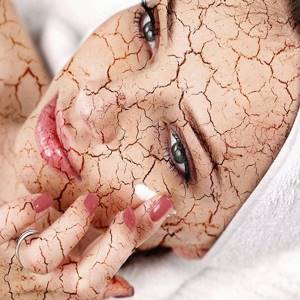
How to use facial serum?
Serums should be applied to cleansed skin after applying facial toner.
Next, the serum must be covered with cream. But some emulsion serums can be left without it; this should be indicated on the packaging of the product.
In general, it is better to use serums with cream from the same line and aimed at one task, since they complement each other and enhance the effect.
The main thing is to choose the right product according to your skin type and the problem being solved.
Basic information
Facial serums are concentrated cosmetic preparations intended for additional care. They are not used as a day or night cream. A characteristic feature of these drugs is their narrow focus of action.
The procedure for applying the serum is simple due to the light texture of the product. The preparations are slightly denser than water and are quickly absorbed by the skin. After using the serum, you must use a cream that matches your skin type.
Kinds
Serums can be used to solve a huge range of cosmetic problems. The following types of funds are distinguished:
- Moisturizing. This is the most popular effect in cosmetology. The preparations usually contain hyaluronic acid. This is a hydrofix that can increase the level of moisture in the epidermis, which helps keep the skin in good condition and slow down its aging.
- Rejuvenating. This type of product contains collagen, which provides a lifting effect. Other additional substances stimulate its synthesis and production of elastin. The complex effect guarantees a successful fight against wrinkles.
- Whitening. Such products solve the problem of uniform distribution of melanin. In addition, they contribute to the renewal of the skin, which ensures an even tone.
- Updating. These are targeted means. They contain components that help eliminate the effects of acne and photoaging.
- Protective. In the manufacture of drugs, special vitamin formulas are used that are aimed at combating the destructive effects of oxidants.

